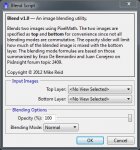I was surprised that I could not find this script already in the forums so I decided to have a go. The "Blend" script will blend two images using any of the blending modes whose PixelMath formulae were detailed in this posting,
http://pixinsight.com/forum/index.php?topic=2409
I have also added a variable opacity slider to allow for adjustment of the amount of mixing of the blended image with the bottom image. This led to the addition of the "Normal" blend mode (simple percentage mixing of the two images) to those enumerated in the posting, namely,
Darken
Multiply
Color Burn
Linear Burn
Lighten
Screen
Color Dodge
Overlay
Soft Light
Hard Light
Vivid Light
Linear Light
Pin Light
Difference
Exclusion
There is nothing here that you can't already do with Pixel Math but maybe it will prove to be a time saver for some. I have attached the script and a screenshot of the popup.
Mike
http://pixinsight.com/forum/index.php?topic=2409
I have also added a variable opacity slider to allow for adjustment of the amount of mixing of the blended image with the bottom image. This led to the addition of the "Normal" blend mode (simple percentage mixing of the two images) to those enumerated in the posting, namely,
Darken
Multiply
Color Burn
Linear Burn
Lighten
Screen
Color Dodge
Overlay
Soft Light
Hard Light
Vivid Light
Linear Light
Pin Light
Difference
Exclusion
There is nothing here that you can't already do with Pixel Math but maybe it will prove to be a time saver for some. I have attached the script and a screenshot of the popup.
Mike

